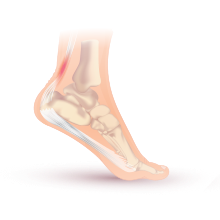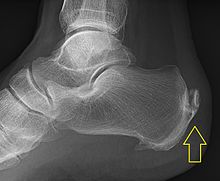Achilles tendinitis
| Achilles tendinitis | |
|---|---|
| Other names | Achilles tendinopathy, Achilles tendonitis, Achilles tenosynovitis |
 | |
| Drawing of Achilles tendinitis with the affected part highlighted in red | |
| Specialty | Rheumatology |
| Symptoms | Pain, swelling around the affected tendon[1] |
| Usual onset | Gradual[1] |
| Duration | Months[2] |
| Types | Noninsertional, insertional[2] |
| Causes | Overuse[2] |
| Risk factors | Trauma, lifestyle that includes little exercise,high-heel shoes,rheumatoid arthritis,medications of thefluoroquinoloneorsteroidclass[1] |
| Diagnostic method | Based on symptoms andexamination[3] |
| Differential diagnosis | Achilles tendon rupture[3] |
| Treatment | Rest, ice,non-steroidal antiinflammatory agents(NSAIDs),physical therapy[1][2] |
| Frequency | Common[2] |
Achilles tendinitis,also known asAchilles tendinopathy,is soreness theAchilles tendon.It is accompanied by alterations in the tendon's structure and mechanical properties.[2]The most common symptoms are pain and swelling around the back of theankle.[1]The pain is typically worse at the start of exercise and decreases thereafter.[3]Stiffness of the ankle may also be present.[2]Onset is generally gradual.[1]
It commonly occurs as a result of overuse such asrunning,[2][3]but also occurs due to injury. Other risk factors include trauma, a lifestyle that includes little exercise,high-heel shoes,rheumatoid arthritis,and medications of thefluoroquinoloneorsteroidclass.[1]Diagnosis is generally based on symptoms andexamination.[3]
There are several simple actions that individuals can take to prevent or reduce tendinitis. Though commonly used, some of these have limited or noscientific evidenceto support them, namely pre-exercise stretching. Strengthening calf muscles, avoiding over-training, and selecting more appropriate footwear are more well-regarded options.[4][5][6]Running mechanics can be improved with simple exercises that will help runners avoid Achilles injury.[7]Treatment typically involves rest, ice,non-steroidal antiinflammatory agents(NSAIDs), andphysical therapy.[1][2]In those whose symptoms last more than six months despite other treatments, surgery may be considered.[2]Achilles tendinitis is relatively common.[2]
Signs and symptoms
[edit]Symptoms can vary from an ache or pain and swelling in the local area of one or both ankles, or a burning that surrounds the wholejoint.With this condition, the pain is usually worse during and after activity, and the tendon and joint area can become stiff the following day, as swelling impinges on the movement of the tendon.
Achilles tendon injuries can be separated into insertional tendinopathy (20%–25% of the injuries), midportion tendinopathy (55%–65%), and proximalmusculotendinous junction(9%–25%) injuries, according to the location of pain.[8]
Cause
[edit]

Achilles tendinitis is a common injury, particularly in sports that involve lunging and jumping, occurs both laterally and bilaterally, and is often induced in a single ankle by trauma. It is also a known side effect offluoroquinolone antibioticssuch asciprofloxacin,as are other types of tendinitis.[9]
Achilles tendinitis is thought to have physiological, mechanical, or extrinsic (i.e. footwear or training) causes. The Achilles tendon has a generally poor blood supply throughout its length, as measured by the number of vessels per cross-sectional area. Blood is supplied via the synovial sheaths that surround it.[10]This lack of blood supply can lead to the degradation of collagen fibers and inflammation.[11]Tightness in the calf muscles has also been known to be involved in the onset of Achilles tendinitis.[12]
During the loading phase of the running and walking cycle, the ankle and foot naturallypronateandsupinateby approximately 5 degrees.[13]Excessivepronation of the foot(over 5 degrees) in thesubtalar jointis a type of mechanical mechanism that can lead to tendinitis.[12][13]
Anoveruse injuryrefers to repeated stress and strain, which is likely the case in endurance runners.[14][15]Overuse can simply mean an increase in running, jumping orplyometric exerciseintensity too soon. Another consideration would be the use of improper or worn-down footwear, which lack the necessary support to maintain the foot in the natural/normal pronation.[15]
Pathophysiology
[edit]Because the Achilles tendon does not have good blood supply, injuries can be slow to heal. The tendon receives nutrients from thetendon sheathor paratendon. When an injury occurs to the tendon, cells from surrounding structures migrate into the tendon to assist in repair. Some of these cells come from blood vessels that enter the tendon to provide direct blood flow to increase healing. With the blood vessels come nerve fibers. Researchers including Alfredson and his team in Sweden believe these nerve fibers to be the cause of the pain - they injected local anaesthetic around the vessels and this decreased significantly the pain in the Achilles tendon.[16]
Diagnosis
[edit]
Achilles tendinitis is usually diagnosed from amedical history,andphysical examinationof the tendon.Projectional radiographyshows calcification deposits within the tendon at itscalcanealinsertion in approximately 60 percent of cases.[17]Magnetic resonance imaging(MRI) can determine the extent of tendon degeneration, and may showdifferential diagnosessuch asbursitis.[17]
Prevention
[edit]
Performing consistent physical activity will improve theelasticityand strength of the tendon, which will assist in resisting the forces that are applied.[19]
Stretchingbefore beginning an exercise session is often recommended, however evidence to support this practice is limited.[4][5]Prevention of recurrence includes following appropriate exercise habits and wearing low-heeled shoes. In the case of incorrect foot alignment,orthoticscan be used to properly position the feet.[19]Footwear that is specialized to provide shock-absorption can be utilized to defend the longevity of the tendon.[20]Achilles tendon injuries can be the result of exceeding the tendon's capabilities forloading,therefore it is important to gradually adapt to exercise if someone is inexperienced,sedentary,or is an athlete who is not progressing at a steady rate.[20]
Eccentric strengthening exercises of thegastrocnemiusandsoleusmuscles are utilized to improve thetensile strengthof the tendon and lengthen the musculotendinous junction, decreasing the amount of strain experienced with ankle joint movements.[21]Thiseccentrictraining method is especially important for individuals with chronic Achillestendinosiswhich is classified as the degeneration of collagen fibers.[20]
Treatment
[edit]Treatment typically involves rest, ice,non-steroidal antiinflammatory agents(NSAIDs), andphysical therapy.[1][2]Aheel lift[22]ororthotics[23]may also be helpful,[3][2]but evidence for either is limited.Foam rollingmay increase range of motion, but there is only weak evidence for the direct treatment of stiffness.[24]Other treatments include:
- Aneccentric exerciseroutine designed to strengthen the tendon.
- Application of a boot or cast.
Injections
[edit]The evidence to support injection therapies is poor.[25]
- This includescorticosteroidinjections.[1]These can also increase the risk of tendon rupture.[25]
- Autologous blood injections- results have not been highly encouraging and there is little evidence for their use.[26][27][1]
Procedures
[edit]Tentative evidence supports the use ofextracorporeal shockwave therapy.[28]
Epidemiology
[edit]Theprevalenceof Achillestendinitisvaries among different ages and groups of people. Achilles tendinitis is most commonly found in individuals aged 30–40[29]Runners are susceptible,[29]as well as anyone participating in sports, and men aged 30–39.[30]
Risk factors include participating in a sport or activity that involves running, jumping, bounding, and change of speed. Although Achilles tendinitis is mostly likely to occur in runners, it also is more likely in participants in basketball, volleyball, dancing, gymnastics and other athletic activities.[29]Other risk factors include gender, age, improper stretching, and overuse.[31]Another risk factor is any congenital condition in which an individual's legs rotate abnormally, which in turn causes the lower extremities to overstretch and contract; this puts stress on the Achilles tendon and will eventually cause Achilles tendinitis.[31]
References
[edit]- ^abcdefghijkHubbard, MJ; Hildebrand, BA; Battafarano, MM; Battafarano, DF (June 2018). "Common Soft Tissue Musculoskeletal Pain Disorders".Primary Care.45(2): 289–303.doi:10.1016/j.pop.2018.02.006.PMID29759125.S2CID46886582.
- ^abcdefghijklmSilbernagel, Karin (2020)."Current Clinical Concepts: Conservative Management of Achilles Tendinopathy".Journal of Athletic Training.55(5): 0–0000.doi:10.4085/1062-6050-356-19.PMC7249277.PMID32267723.
- ^abcdef"Achilles Tendinitis".MSD Manual Professional Edition.March 2018.Retrieved27 June2018.
- ^abPark, DY; Chou, L (December 2006). "Stretching for prevention of Achilles tendon injuries: a review of the literature".Foot & Ankle International.27(12): 1086–95.doi:10.1177/107110070602701215.PMID17207437.S2CID8233009.
- ^abPeters, JA; Zwerver, J; Diercks, RL; Elferink-Gemser, MT; van den Akker-Scheek, I (March 2016)."Preventive interventions for tendinopathy: A systematic review".Journal of Science and Medicine in Sport.19(3): 205–211.doi:10.1016/j.jsams.2015.03.008.PMID25981200.
- ^"Achilles tendinitis - Symptoms and causes".Mayo Clinic.Retrieved27 June2018.
- ^"Avoid Achilles injuries by adding these three exercises to your routine".3 December 2019.
- ^Kvist, M (1991). "Achilles tendon injuries in athletes".Ann Chir Gynaecol.80(2): 188–201.PMID1897886.
- ^"FDA orders 'black box' label on some antibiotics".CNN.8 July 2008.Retrieved8 July2008.
- ^Kader, D.; Saxena, A.; Movin, T.; Maffulli, N. (2002-08-01)."Achilles tendinopathy: some aspects of basic science and clinical management".British Journal of Sports Medicine.36(4): 239–249.doi:10.1136/bjsm.36.4.239.ISSN0306-3674.PMC1724537.PMID12145112.
- ^Fenwick S. A.; Hazleman B. L.; Riley G. P. (2002)."The vasculature and its role in the damaged and healing tendon".Arthritis Research.4(4): 252–260.doi:10.1186/ar416.PMC128932.PMID12106496.
- ^abMaffulli N.; Sharma P.; Luscombe K. L. (2004)."Achilles tendinopathy: aetiology and management".Journal of the Royal Society of Medicine.97(10): 472–476.doi:10.1177/0141076809701004.PMC1079614.PMID15459257.
- ^abHintermann B., Nigg B. M. (1998). "Pronation in runners".Sports Medicine.26(3): 169–176.doi:10.2165/00007256-199826030-00003.PMID9802173.S2CID24812917.
- ^Kannus P (1997). "Etiology and pathophysiology of chronic tendon disorders in sports".Scandinavian Journal of Sports Medicine.7(2): 78–85.doi:10.1111/j.1600-0838.1997.tb00123.x.PMID9211608.S2CID664841.
- ^abMcCrory J. L.; Martin D. F.; Lowery R. B.; Cannon D. W.; Curl W. W.; Read Jr H. M.; Hunter D.M.; Craven T.; Messier S. P. (1999)."Etiologic factors associated with Achilles tendinitis in runners".Medicine and Science in Sports and Exercise.31(10): 1374–1381.doi:10.1097/00005768-199910000-00003.PMID10527307.S2CID25204643.
- ^Alfredson, H.; Ohberg, L.; Forsgren, S. (Sep 2003). "Is vasculo-neural ingrowth the cause of pain in chronic Achilles tendinosis? An investigation using ultrasonography and colour Doppler, immunohistochemistry, and diagnostic injections".Knee Surg Sports Traumatol Arthrosc.11(5): 334–8.doi:10.1007/s00167-003-0391-6.PMID14520512.S2CID12264939.
- ^ab"Insertional Achilles Tendinitis".American Orthopaedic Foot & Ankle Society.Retrieved2017-01-17.
- ^Floyd, R.T. (2009). Manual of Structural Kinesiology. New York, NY: McGraw Hill
- ^abHess G.W. (2009). "Achilles Tendon Rupture: A Review of Etiology, Population, Anatomy, Risk Factors, and Injury Prevention".Foot & Ankle Specialist.3(1): 29–32.doi:10.1177/1938640009355191.PMID20400437.S2CID19237310.
- ^abcAlfredson H., Lorentzon R. (2012)."Chronic Achilles Tendinosis: Recommendations for Treatment and Prevention".Sports Medicine.29(2): 135–146.doi:10.2165/00007256-200029020-00005.PMID10701715.S2CID36957036.
- ^G T Allison, C Purdam. Eccentric loading for Achilles tendinopathy — strengthening or stretching?Br J Sports Med2009;43:276-279
- ^Munteanu, Shannon (3 November 2014)."Customised foot orthoses for Achilles tendinopathy RCT: responding to the critics".British Journal of Sports Medicine.
- ^Munteanu, Shannon (2015)."Effectiveness of customised foot orthoses for Achilles tendinopathy: a randomised controlled trial".British Journal of Sports Medicine.49(15): 989–994.doi:10.1136/bjsports-2014-093845.PMID25246441.S2CID5588570.
- ^Baumgart, Christian (2019)."Foam Rolling of the Calf and Anterior Thigh: Biomechanical Loads and Acute Effects on Vertical Jump Height and Muscle Stiffness".Sports.7(1): 27.doi:10.3390/sports7010027.PMC6359537.PMID30669477.
- ^abKearney, RS; Parsons, N; Metcalfe, D; Costa, ML (26 May 2015)."Injection therapies for Achilles tendinopathy"(PDF).The Cochrane Database of Systematic Reviews(5): CD010960.doi:10.1002/14651858.CD010960.pub2.PMID26009861.
- ^"JBJS | Limited Evidence Supports the Effectiveness of Autologous Blood Injections for Chronic Tendinopathies".jbjs.org.2012. Archived fromthe originalon March 29, 2012.RetrievedFebruary 12,2012.
- ^de Vos RJ, van Veldhoven PL, Moen MH, Weir A, Tol JL, Maffulli N (2012)."Autologous growth factor injections in chronic tendinopathy: a systematic review".bmb.oxfordjournals.org.Archived fromthe originalon April 15, 2013.RetrievedFebruary 12,2012.
- ^Korakakis, V; Whiteley, R; Tzavara, A; Malliaropoulos, N (March 2018)."The effectiveness of extracorporeal shockwave therapy in common lower limb conditions: a systematic review including quantification of patient-rated pain reduction".British Journal of Sports Medicine.52(6): 387–407.doi:10.1136/bjsports-2016-097347.PMID28954794.
- ^abcLeach R. E.; James S.; Wasilewski S. (1981). "Achilles tendinitis".The American Journal of Sports Medicine.9(2): 93–98.doi:10.1177/036354658100900204.PMID7223927.S2CID10111816.
- ^Leppilant J.; Puranen J.; Orava S. (1996)."Incidence of Achilles Tendon Injury".Acta Orthopaedica.67(3): 277–79.doi:10.3109/17453679608994688.PMID8686468.
- ^abKainberger, F; Fialka, V; Breitenseher, M; Kritz, H; Baldt, M; Czerny, C; Imhof, H (1996). "Differential diagnosis of diseases of the Achilles tendon. A clinico-sonographic concept".Der Radiologe.36(1): 38–46.doi:10.1007/s001170050037.PMID8820370.S2CID25971164.
